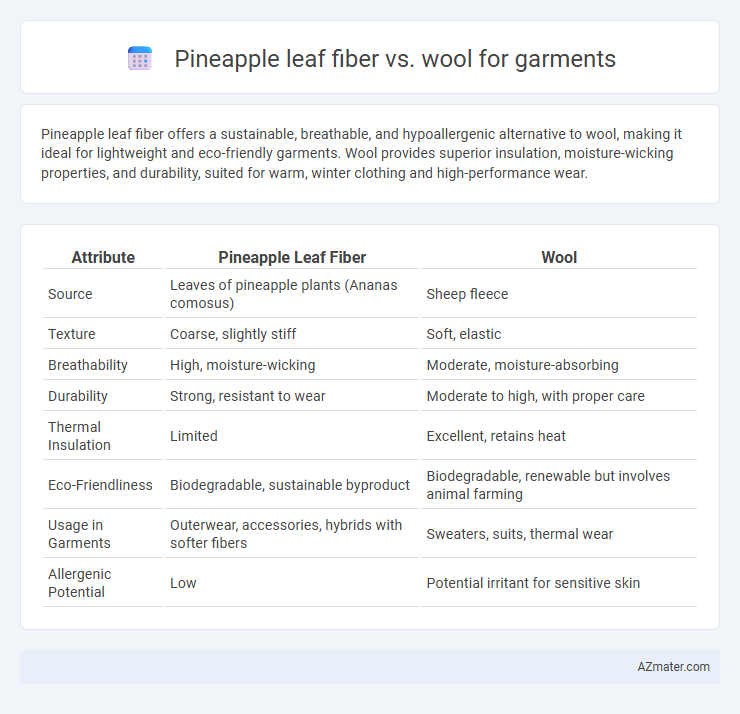Pineapple leaf fiber offers a sustainable, breathable, and hypoallergenic alternative to wool, making it ideal for lightweight and eco-friendly garments. Wool provides superior insulation, moisture-wicking properties, and durability, suited for warm, winter clothing and high-performance wear.
Table of Comparison
| Attribute | Pineapple Leaf Fiber | Wool |
|---|---|---|
| Source | Leaves of pineapple plants (Ananas comosus) | Sheep fleece |
| Texture | Coarse, slightly stiff | Soft, elastic |
| Breathability | High, moisture-wicking | Moderate, moisture-absorbing |
| Durability | Strong, resistant to wear | Moderate to high, with proper care |
| Thermal Insulation | Limited | Excellent, retains heat |
| Eco-Friendliness | Biodegradable, sustainable byproduct | Biodegradable, renewable but involves animal farming |
| Usage in Garments | Outerwear, accessories, hybrids with softer fibers | Sweaters, suits, thermal wear |
| Allergenic Potential | Low | Potential irritant for sensitive skin |
Introduction to Pineapple Leaf Fiber and Wool
Pineapple leaf fiber is a sustainable, plant-based material derived from the leaves of the pineapple plant, known for its strength, durability, and eco-friendly properties in textile manufacturing. Wool, a natural animal fiber obtained from sheep, offers excellent insulation, moisture-wicking capabilities, and a soft texture ideal for garments requiring warmth and comfort. Both fibers present unique advantages, with pineapple leaf fiber emphasizing sustainability and breathability, while wool excels in thermal regulation and elasticity.
Source and Sustainability of Each Fiber
Pineapple leaf fiber is derived from the leaves of the pineapple plant, a renewable agricultural byproduct that requires minimal water and no pesticides, making it a highly sustainable material. Wool comes from the fleece of sheep, a natural, renewable fiber that supports biodiversity but involves greater land use and water consumption compared to pineapple leaf fiber. While both fibers offer biodegradable options for garments, pineapple leaf fiber stands out in sustainability due to its low environmental impact and efficient resource utilization.
Fiber Properties and Structure Comparison
Pineapple leaf fiber exhibits high tensile strength, coarse texture, and greater stiffness due to its cellulose-rich structure, making it suitable for durable, breathable garments with natural moisture-wicking properties. Wool fibers consist of keratin protein with a complex scale-like surface and crimped structure, providing excellent elasticity, insulation, and softness, ideal for warmth-retentive and flexible clothing. While pineapple leaf fiber is more rigid and less elastic, its biodegradability and sustainability contrast with wool's superior thermal regulation and resilience.
Environmental Impact: Pineapple Leaf Fiber vs Wool
Pineapple leaf fiber is a sustainable and biodegradable material derived from agricultural waste, reducing environmental pollution and deforestation associated with traditional fiber production. Wool, while renewable and durable, requires significant land, water resources, and emits methane during sheep rearing, contributing to greenhouse gas emissions. The cultivation of pineapple leaves promotes waste utilization and lower carbon footprint compared to the resource-intensive processes required for wool production.
Comfort and Wearability in Garments
Pineapple leaf fiber offers a lightweight, breathable texture that enhances comfort in warm climates, making it ideal for summer garments, while wool provides superior insulation and moisture-wicking properties suitable for colder conditions. Pineapple fiber is less elastic yet known for its strength and durability, leading to garments that retain shape but may feel stiffer compared to the soft, flexible stretch of wool. Wool's natural crimps trap air for warmth and comfort, whereas pineapple leaf fiber promotes airflow, improving wearability through temperature regulation and eco-friendly qualities.
Durability and Longevity of Textiles
Pineapple leaf fiber offers remarkable durability and resistance to wear, making it an eco-friendly alternative to traditional textiles with strong tensile strength and natural moisture-wicking properties. Wool excels in longevity due to its natural elasticity and resilience, providing excellent insulation and resistance to pilling and abrasion over extended use. While pineapple leaf fiber garments maintain structural integrity in humid climates, wool garments perform better in colder environments by retaining warmth and shape through repeated wear and laundering.
Moisture Absorption and Breathability
Pineapple leaf fiber offers superior moisture absorption and breathability compared to wool, making it ideal for garments worn in hot and humid conditions. Its natural cellulose structure efficiently wicks moisture away from the skin while allowing air circulation, reducing sweat retention and improving comfort. Wool, while breathable and moisture-wicking, retains some moisture due to its protein-based fibers, which can lead to longer drying times and less overall ventilation.
Dyeing, Coloring, and Aesthetic Qualities
Pineapple leaf fiber exhibits excellent dye absorption and vibrant color retention due to its natural cellulose content, resulting in bright, long-lasting hues ideal for eco-conscious garments. Wool offers superior dye affinity with rich, deep tones and exceptional colorfastness, enhancing its luxurious texture and warmth in apparel. While pineapple leaf fiber provides a crisp, matte finish with a unique natural texture, wool delivers a soft, tactile aesthetic with natural elasticity and luster, catering to different fashion and functional preferences.
Ethical Considerations in Fiber Selection
Pineapple leaf fiber offers a sustainable alternative to wool, as it is derived from agricultural waste, reducing environmental impact and promoting zero-waste practices. Wool production raises ethical concerns regarding animal welfare, including issues related to shearing methods and land use intensity that can contribute to habitat degradation. Choosing pineapple leaf fiber supports cruelty-free fashion and aligns with eco-conscious consumer demands for renewable, biodegradable materials.
Market Trends and Future Prospects
Pineapple leaf fiber is gaining traction in the garment industry due to its sustainability, biodegradability, and lower environmental impact compared to traditional wool, which remains valued for its warmth and durability. Market trends indicate a growing consumer preference for eco-friendly fabrics, accelerating investments in pineapple fiber innovations and expanding applications beyond apparel to accessories and home textiles. Future prospects for pineapple leaf fiber include scalability improvements and blending with other natural fibers to enhance texture and strength, positioning it as a competitive alternative to wool in sustainable fashion markets.

Infographic: Pineapple leaf fiber vs Wool for Garment
 azmater.com
azmater.com